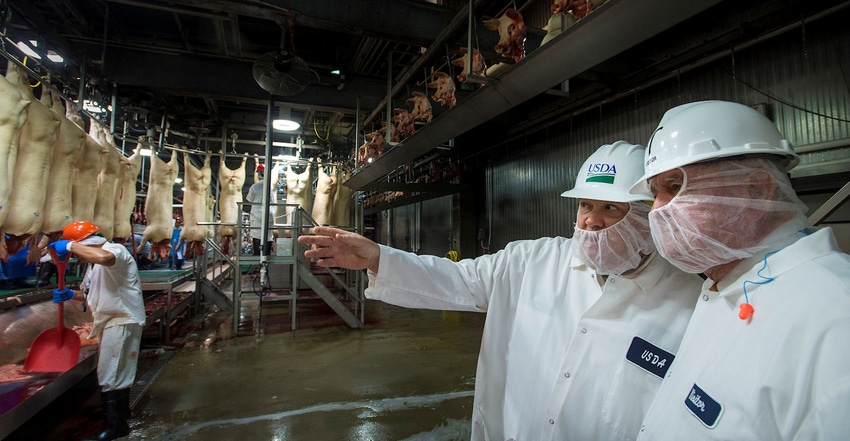Pilot project in five pork plants for 15 years now expanded for nationwide use.

The U.S. Department of Agriculture is proposing to amend the federal meat inspection regulations to establish a new voluntary inspection system for market hog slaughter establishments called the New Swine Slaughter Inspection System (NSIS), while also requiring additional pathogen sampling for all swine slaughter establishments.
The new pork processing inspection rule is based on the USDA’s Food Safety & Inspection Service (FSIS) HACCP Inspection Model (HIMP) which will be expanded from five current pilot locations to full-scale implementation.
For market hog establishments that opt into NSIS, the proposed rule would increase the number of offline USDA inspection tasks, while continuing 100% FSIS carcass-by-carcass inspection. These offline inspection tasks place inspectors in areas of the production process where they can perform critical tasks that have direct impact on food safety.
“FSIS is excited to continue modernizing inspection practices, while allowing opportunities for industry to innovate and streamline food production,” said acting deputy under secretary for food safety Carmen Rottenberg. “There is no single technology or process to address the problem of foodborne illness, but when we focus our inspections on food safety-related tasks, we better protect American families.”
In this proposal, USDA would also amend the regulations that apply to all establishments that slaughter swine. The new requirements would ensure that establishments implement measures to control enteric pathogens that can cause foodborne illness. Specifically, all swine slaughter establishments would be required to implement appropriate measures to prevent contamination throughout the entire production process in their hazard analysis and critical control points (HACCP) plans, Sanitation Standard Operating Procedures (Sanitation SOPs) or other prerequisite programs. The new requirements would ensure that both USDA and the establishment have the documentation they need to verify the effectiveness of these measures on an ongoing basis.
The industry welcomed the announcement, offering support for science-based inspection models that better utilize government resources while maintaining strong food safety standards.
North American Meat Institute president and CEO Barry Carpenter said the proposed NSIS has been used as a pilot project in five pork plants for 15 years, and it has proven to be a strong inspection model.
“Those five pilot plants have produced millions of pounds of safe pork. We look forward to working with the agency as it develops a final rule that maintains a strong level of food safety in the most efficient manner,” Carpenter said.
“We support the USDA’s decision to advance HIMP as it introduces new pork production efficiencies while encouraging the deployment of new food safety technologies in packing plants,” added National Pork Producers Council president Ken Maschhoff, a pork producer from Carlyle, Illinois. “The pilot program yielded very positive results; expanding the program is another step forward in the industry’s ongoing focus on continuous improvement of food safety and cost efficiency.”
The new inspection model assigns increased inspection responsibility to plant operators, allowing USDA to dedicate its resources to general oversight of food safety standards and the overall inspection process. Plants can choose to adopt the HIMP model or continue operating under the current inspection system.
Maschhoff added, “The U.S. pork industry is the most competitive in the world because we have built a reputation for quality, affordability and food safety. We applaud the USDA for taking this step to strengthen our competitive position.”
However, other groups remained concerned that the move would “privatize” the food safety inspection system. Food & Water Watch said the “driving force behind this change is the U.S. Department of Agriculture’s goal of reducing the number of government inspectors in hog slaughter plants and the pork industry’s goal of increasing their line speeds.”
Food & Water Watch cited a 2013 USDA Inspector General audit that found that after 15 years of the pilot program’s existence, USDA could not determine whether the goals of the program were met because of inadequate oversight.
Specifically, the audit said: “Since FSIS did not provide adequate oversight, HIMP plants may have a higher potential for food safety risks. Nationwide, 3 of the 10 plants cited with the most NRs [noncompliance records] continue to participate in the HIMP program … In fact, the swine plant with the most NRs during this timeframe was a HIMP plant — with nearly 50% more NRs than the plant with the next highest number.”
In addition, Food & Water Watch said, “the USDA has recently changed its performance standards for rates of microbial contamination in pork, including eliminating salmonella testing in slaughter plants, which essentially makes it impossible for the agency to establish a baseline for acceptable performance for plants under traditional inspection or this proposed new system.”
There will be a 60-day period for comment once the rule is published in the Federal Register.
About the Author(s)
You May Also Like



.png?width=300&auto=webp&quality=80&disable=upscale)

